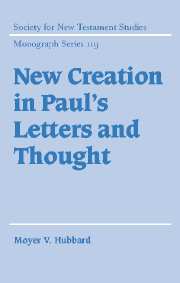Book contents
- Frontmatter
- Contents
- Acknowledgments
- List of abbreviations
- 1 Introduction: the current debate
- PART I NEW CREATION: CENTRAL JEWISH TEXTS
- Part II FROM DEATH TO LIFE: NEW CREATION IN THE CONTOURS OF PAUL'S THOUGHT
- Part III THE OLD AND THE NEW: NEW CREATION IN THE CONTEXT OF PAUL'S LETTERS
- 10 If anyone be in Christ: 2 Corinthians 5.17
- 11 Neither circumcision nor uncircumcision: Galatians 6.15
- 12 Summary and conclusions
- References
- Index of passages cited
- Index of modern authors
11 - Neither circumcision nor uncircumcision: Galatians 6.15
Published online by Cambridge University Press: 02 December 2009
- Frontmatter
- Contents
- Acknowledgments
- List of abbreviations
- 1 Introduction: the current debate
- PART I NEW CREATION: CENTRAL JEWISH TEXTS
- Part II FROM DEATH TO LIFE: NEW CREATION IN THE CONTOURS OF PAUL'S THOUGHT
- Part III THE OLD AND THE NEW: NEW CREATION IN THE CONTEXT OF PAUL'S LETTERS
- 10 If anyone be in Christ: 2 Corinthians 5.17
- 11 Neither circumcision nor uncircumcision: Galatians 6.15
- 12 Summary and conclusions
- References
- Index of passages cited
- Index of modern authors
Summary
But the Lord said to Samuel, “Do not look at his appearance, or at the height of his stature, because I have rejected him”.
1 Samuel 16.7Galatians: recent issues in interpretation
Pauline studies have undergone something of a Copernican revolution in recent years, and the epistle to the Galatians has figured prominently in every reconfiguration of the Pauline solar system. The critical issues raised by the “new perspective” on Paul concern, among other things, the nature of first-century “Judaism” – a controversial term in itself – and the reason(s) behind Paul's rejection of his “former way of life in Judaism” (Gal. 1.13). Because Galatians is one of our primary sources in this debate, scholarly writing on this letter has been (rightly) preoccupied with this subject, and this is reflected in the “ever-burgeoning literature” on the theme. Indeed, the “new perspective” has generated a whole body of material devoted solely to keeping up with the debate.
A second important issue in the interpretation of Galatians, though perhaps not of Copernican magnitude, gained prominence with the publication of Hans Dieter Betz's Hermeneia commentary, which analyzed the argument of Galatians in terms of classical rhetorical theory. Betz's work has been challenged and modified in a number of ways, though most would accept that the relationship between structure and meaning so ably illustrated by Betz's exegesis had not been fully appreciated prior to his detailed rhetorical analysis.
Given the all-encompassing nature of these two issues, it may come as a surprise to discover that Paul's new-creation motif in Galatians may be pursued largely independently of these interpretive maelstroms.
- Type
- Chapter
- Information
- New Creation in Paul's Letters and Thought , pp. 188 - 232Publisher: Cambridge University PressPrint publication year: 2002
- 1
- Cited by

